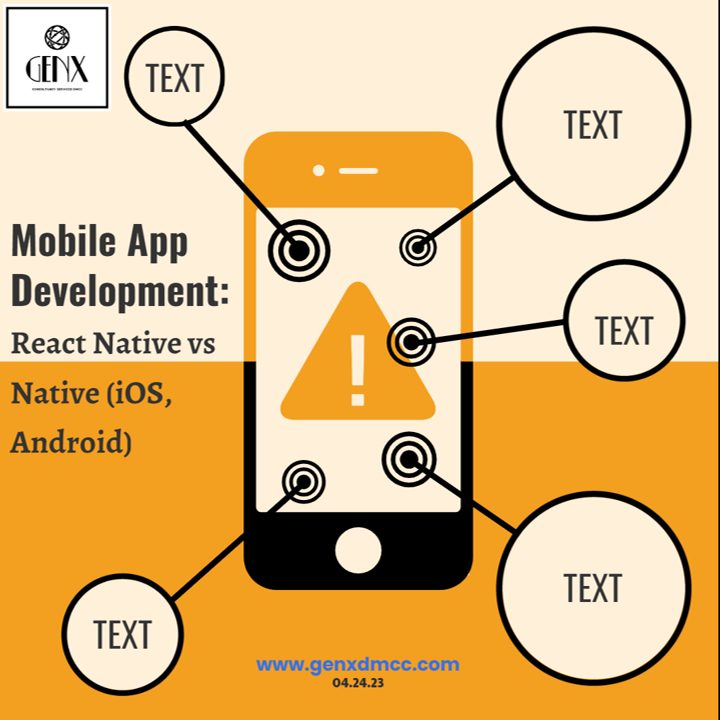
Mobile App Development: React Native vs Native (iOS, Android)

Mobile app development is the process of creating software applications that run on mobile devices, such as smartphones and tablets. It involves designing, coding, testing, and deploying apps for various mobile platforms, such as Android, iOS, and Windows Phone.
The development of mobile apps involves a variety of technologies and tools, including programming languages like Java, Swift, and Kotlin, and development frameworks like React Native and Flutter. In addition, mobile app developers need to consider the user experience, device compatibility, security, and performance when creating mobile applications.
Mobile apps can serve a variety of purposes, such as social networking, e-commerce, gaming, and productivity, among others. They can be developed for businesses, organizations, or individuals and can be distributed through app stores or other channels.
The mobile app development industry has grown significantly in recent years, with more and more businesses and individuals seeking to create mobile apps for various purposes. As mobile devices become increasingly popular, the demand for mobile apps is likely to continue to grow in the coming years.
React Native is a cross-platform development framework that allows developers to build mobile applications for iOS and Android platforms using a single codebase. Native development, on the other hand, involves building separate applications for each platform using native programming languages and tools.
One of the main advantages of React Native is that it allows developers to build applications quickly and cost-effectively, as they can reuse much of the code across both platforms. Additionally,
React Native offers hot reloading, which allows developers to see changes to the app in real-time, as well as a large ecosystem of third-party libraries and tools.
With the rise of React Native popularity and the growing number of popular mobile apps (such as Facebook, Instagram, Pinterest, Uber, Discord, SoundCloud, Skype…)
React Native framework uses React.js library in order to create a true native mobile app. The important difference between React and React Native is that the latter uses native components instead of web components to create the user interface, along with JSX — a syntax that is used to embed XML with JavaScript.
Codebase
React Native enables a single JavaScript codebase for 2 different platforms. This means that it is not just easier to maintain the app by having the same development process for both platforms and reusing the same code, but it also requires less resources, because there is no need for separate iOS and Android teams.
However, this benefit comes with a cost. It is well-known that Android and iOS have different design guidelines. Human Interface Guideline for iOS and Material Design for Android have a big share of differences, so if the project requirements dictate that these specific OS requirements should be followed for each native platform, React Native developer will need to write platform-specific code, which defeats the purpose of the single codebase. This might be a bigger issue when it comes to iOS, because Apple often updates and deprecates their technologies which can be hard to follow, while Android apps generally have more control of the system and are allowed more freedom.
User Interface
React Native’s approach to structuring UI is Flexbox, which is already very popular in web development and enables the developer to create a responsive web or mobile UI very easily. As such, it is a technology that rivals Android’s XML / Constraint layout approach, or iOS’s Storyboard / XIB / Coding with UI libraries such as Neon approach.
Native modules
While React Native can handle a large amount of cross-platform use cases, it is impossible for it to cover all the native mobile ground. This means that there will always be a need for native modules. Native modules are basically code in native language which handles a specific native feature. Examples of native modules are modules for camera, native image picker, push notifications, deep linking, and third-party services like Auth0 or Amplitude.
React Native is much more effective if used by developers who already have experience with native mobile development, because it doesn’t completely remove the need of going native.
Native development, on the other hand, provides a more granular level of control over the development process, allowing developers to optimize the performance of their applications for each platform. Native apps also typically have better access to platform-specific features and functionality, which can be important for certain types of applications.
Ultimately, the choice between React Native and native development depends on the specific needs of the application and the resources available to the development team. React Native can be a good choice for applications that need to be developed quickly and for businesses with limited resources, while native development may be more appropriate for applications with complex functionality or for businesses with more substantial development budgets.